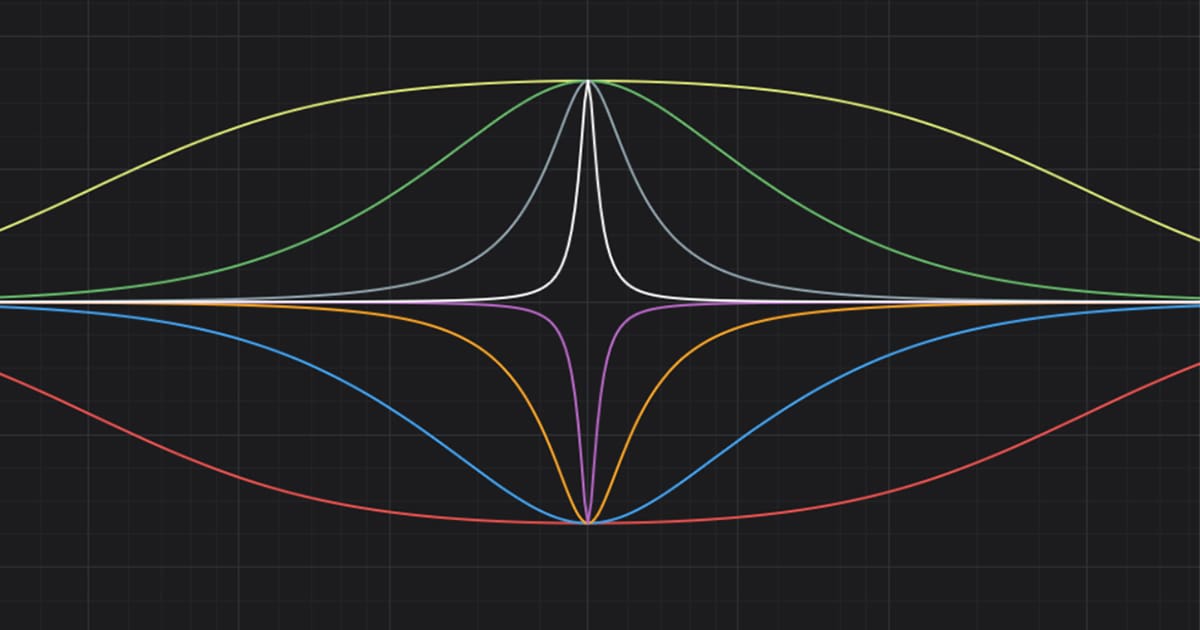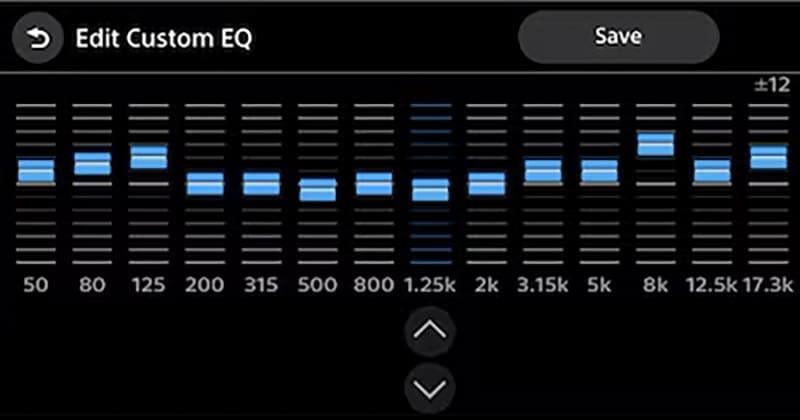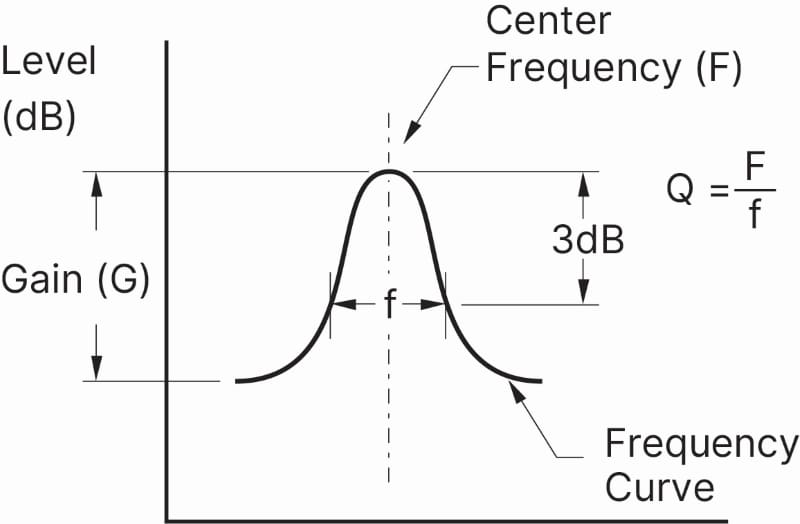When looking at the options for frequency response correction for audio systems, your installer has two choices: graphic or parametric equalizers. Both types of equalizers perform the same task in helping to smooth the peaks and dips in what you hear from your audio system. However, the two equalizer types deliver the same results in very different ways. Let’s take a deep look into parametric equalizers and explain how they work.
What Is a Car Audio Equalizer?
As we covered in a previous article, an equalizer is a device that allows your installer to focus on a specific frequency range and either increase or decrease the level relative to the rest of the music. Equalizers must be used with a real-time audio analyzer to correct for anomalies in the frequency response of an audio system. Everything from your smartphone and smart speaker on your bedside table to movie theaters and concert venues uses equalizers to improve an audio system’s frequency response.
What Is a Graphic Equalizer?
Before diving into the operation of a parametric equalizer, we should review how a graphic equalizer works. The number of bands included in a graphic equalizer indicates their suitability and capabilities. Each of these adjustments is called a band. Each band is assigned a specific frequency in a graphic equalizer (or EQ for short), and the number of bands defines the range of frequencies each covers. For example, if you have a 31-band graphic equalizer, each band will cover about 1/3 of an octave. Conversely, each band covers an entire octave if you have a 10-band graphic equalizer.
The technician can boost or cut these bands based on acoustic measurements made with a calibrated real-time audio analyzer. For example, if there is a 4-dB dip in frequency response at 1 kHz, the technician can boost the 1-kHz EQ band by 4 kHz. Graphic equalizers are very common in higher-end aftermarket car radios.
What Is a Parametric Equalizer?
Though the purpose is the same, parametric equalizers can be more flexible than their graphic cousins. In a parametric equalizer, your technician can select a specific center frequency and bandwidth for each equalizer band. For example, suppose a peak in a system’s frequency response is at 1.1 kHz. In that case, the technician can specify 1.1 kHz as the center frequency of the EQ and then apply whatever amount of attenuation is required to flatten that peak.
A parametric equalizer has a bandwidth adjustment labeled as Q. The concept of Q, or more specifically, Q-factor, is initially unintuitive. The Q-factor represents the ratio of the center frequency to the bandwidth the adjustment covers. A high-Q filter is very narrow, and the low-Q filter affects a broader band of frequencies.
How Is the Q-Factor Calculated?
The calculation to determine the Q-factor of an equalizer adjustment is relatively simple. That said, it’s not arithmetic we typically need to perform when calibrating an audio system. If you look at the image below, you can see the center frequency of the adjustment represented by the uppercase letter F. This would be something like 1.1 kHz, as mentioned in the previous paragraph. The following required information is the -3 dB bandwidth of the range over which the filter adjusts. Let’s use the example of the low-side to high-side -3 dB frequencies being 3,300 hertz apart. The lowercase letter f defines this bandwidth. To calculate the Q-factor, you would divide F by f, 1,100 ÷ 3,300, which equals 0.33. As you can imagine, it would take some measurement to determine the bandwidth of the -3 dB frequencies, so we never do the math to make adjustments.
A higher Q filter might be required if the technician needs to address a very narrow spike or dip. Let’s say that only 1,100 hertz of bandwidth requires boosting or attenuating. Our equation now becomes 1,100 ÷ 1,100 for a value of 1.
Common Q-Factor Knowledge
There are a few pretty common Q-factor values. If the technician wants a parametric equalizer to act like a 1/3-octave graphic equalizer, then a Q-factor of 4.318 will work. If you don’t have many equalizer bands, common in several car audio signal processors, and they want each band to cover an entire octave, then a Q-factor of 1.414 is ideal. These are often the default settings in many systems, though they are rarely suitable for any particular system.
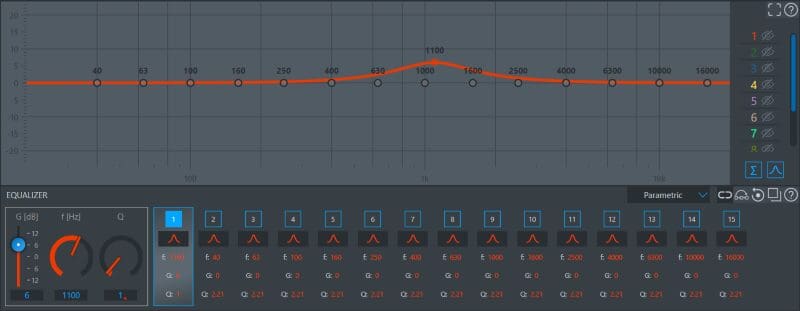
An example of the Audison bitDrive software showing a single EQ band at 1 kHz, with a boost of 6 dB with a Q-factor of 1.42.
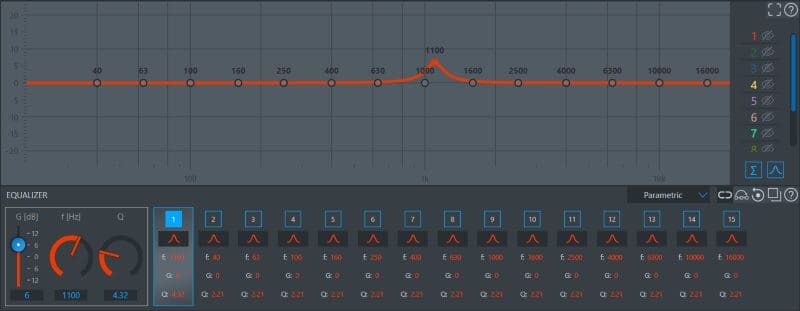
The same digital signal processor software, now showing 6 dB of boost at 1 kHz with a Q-factor of 4.32.
The two images above show how a higher Q-factor affects a narrower range of frequencies. The image below is the ARC DNA software used with the Blackbird amplifier. It allows for Q-factors as low as 0.1 up to 20. The image below shows four equalizer bands, each set to add 10 dB of signal boost at a center frequency of 500 hertz. The white trace has a Q-factor of 10. The gray trace has a Q-factor of two. The green trace has a Q-factor of 0.5. Finally, the yellow trace has a Q-factor of 0.1. It’s unlikely you’d need the widest bandwidth adjustments, but they can come in handy on some processors that don’t have shelving filters.

An example of four bandwidth adjustments shown using the ARC DNA software used with the Blackbird DSP amplifier.
Benefits and Drawbacks of Parametric Equalizers
The most significant benefit of a parametric equalizer is that it can zero in on specific frequency response issues quite easily. As mentioned, if a peak or valley is at 900 hertz or 1,100 hertz, then a parametric EQ is a better tool than a graphic EQ band. Many technicians and amateur enthusiasts get hung up on over-equalizing audio systems. Understanding how to interpret measurements from an RTA is crucial to making an audio system sound accurate.
A drawback of many parametric equalizers is that they are often limited in the number of adjustment bands they offer. Some processors have eight, 10 or 15 bands of parametric equalization. This is typically adequate to adjust a single speaker in a fully active three-way system, but fewer than 10 bands might be somewhat limited when used in a two-way application. We’ve seen several digital signal processors with more than 30 bands of equalization with parametric modes. In short, those will have enough adjustability for any system configuration and likely enough to get an amateur into lots of trouble.
What Is a Paragraphic Equalizer?
Just when you think you have a handle on graphic and parametric equalizers, we’ll throw in a third option: the paragraphic equalizer. As you can imagine, this is a hybrid of the graphic and parametric types. A paragraphic equalizer typically allows you to adjust the center frequency of each equalization band but not the Q-factor. These aren’t very common in car audio applications.
Is A Parametric Equalizer Necessary?
The type of equalizer used to calibrate an audio system is much less important than the accuracy and relevance of the system’s frequency response measurement. A technician’s experience in understanding what the RTA shows. It’s not uncommon for someone to adjust a system to deliver what looks like a smooth response on the computer screen, only to have it sound like it still needs work in certain frequencies. Parametric equalizers are powerful tools and can be an ideal solution to calibrate any audio system, but as with any tool, the craftsman’s skill matters the most.
When it’s time to take your car audio system to the next level, drop by a local specialty mobile enhancement retailer and ask about adding a digital signal processor to your car audio system with an adequately powerful graphic or parametric equalizer. Make sure they have extensive experience in proper audio system design and calibration, which is the key to reproducing music with realism and accuracy.
This article is written and produced by the team at www.BestCarAudio.com. Reproduction or use of any kind is prohibited without the express written permission of 1sixty8 media.
